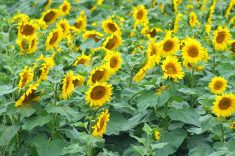CNS– The development of canola was clearly at varying stages of development in east central and southeast Saskatchewan during the third day of a crop tour organized by CWB (formerly the Canadian Wheat Board).
On July 30, participants took a circuitous tour starting in Yorkton, then going northwest to Melfort, before once again heading south to end in Weyburn. Along the way observers saw canola stands in multiple stages of development.
Early bolting was seen on some stands near Yorkton, most of which were clearly shorter than crops in much of Manitoba. Crops were significantly delayed with one producer pegging the lateness at eight to 10 days behind. Frost is constantly cited by producers as their No.1 fear heading into harvest.
Read Also

Survey looks to gauge whether producers are aware of free agronomic tools and where producer funds are going
Survey looks to gauge whether producers are aware of free agronomic tools and where producer funds are going
Observers stopped at one field northwest of Yorkton to see how excess precipitation had affected canola. Soil conditions were wet with canola pods on the small side; one participant noted some pods also appear to have been aborted. Near that same site a field of spring wheat had just finished flowering with good, clean heads. A stand of barley, just east of Wadena, had good kernels and appeared disease free despite moisture stress. One participant called it (the barley crop) the most advanced crop in the area by far.
Past Watson (east central), spring wheat appeared more advanced than canola with some foxtail in the area.
Canola appeared slightly more advanced once the tour ventured past Canora, Saskatchewan, also in the east central part of the province.
In the northeast, canola fields near Melfort appeared well advanced but got patchier travelling south past Tisdale.
Spring wheat crops near Melfort were past the flowering stage. Close inspection of one field drew measurements of 34, 37 and 45 stems within a 12-inch frame with kernel counts in the mid 30s. Standing water was visible on both sides of the highway heading south from Tisdale.
Close to Weyburn, producer Brad Eggum said the area received three and a half inches of rain on the July 1 weekend. However since then, certain crops like spring wheat and soybeans have recovered nicely. But, the same couldn’t be said for later-seeded cereals and canola.
“Some of that took it on the chin a little more because they were quite immature seedlings when the big rain came,” Eggum said.
Lentils and peas took the moisture the hardest and suffered root rot, however barley, durum and spring wheat look consistent.
“I think some of the crops that looked quite rough earlier on are going to be OK to average. There’s a very good-looking flax crop through the area,” said Eggum.
While one nearby canola crop appeared well advanced with thick stems and a healthy canopy, Eggum says canola is patchier than many of the other crops. In general though, he’s optimistic it will produce decent yields.
“We did yield estimates today. Some of the numbers we were looking at today are indicating they’ll be good if not meeting some of those numbers (last year) on the early cereals and the canola,” he added.
Dave Sims writes for Commodity News Service Canada, a Winnipeg company specializing in grain and commodity market reporting.














